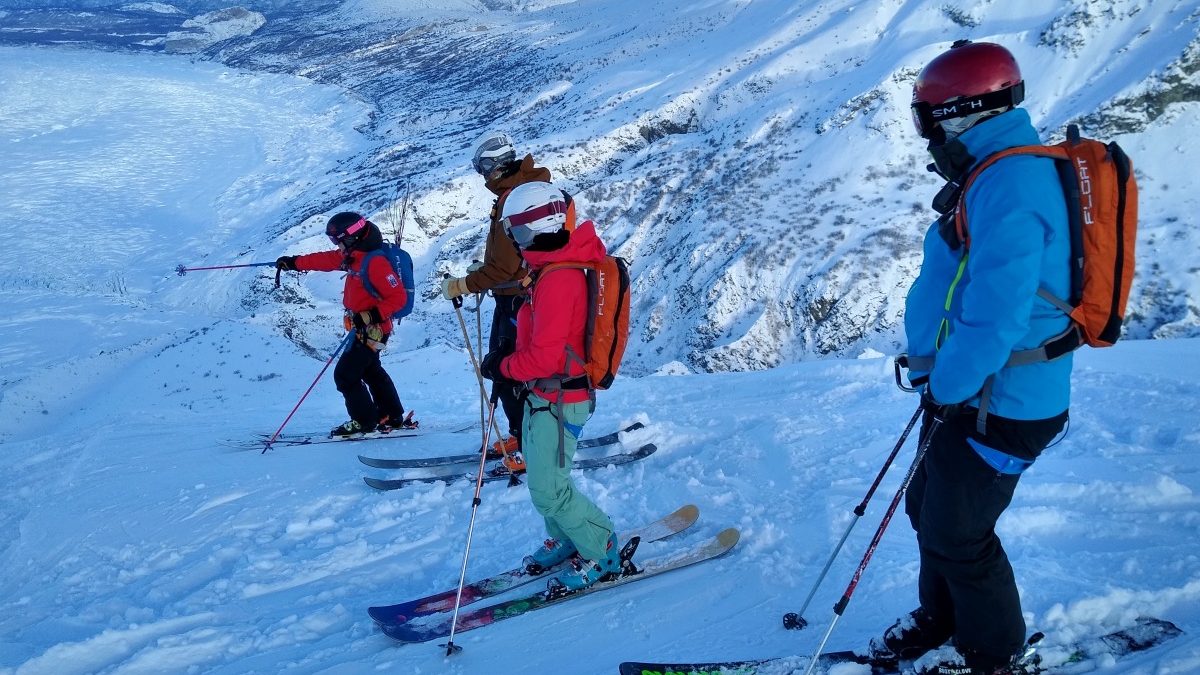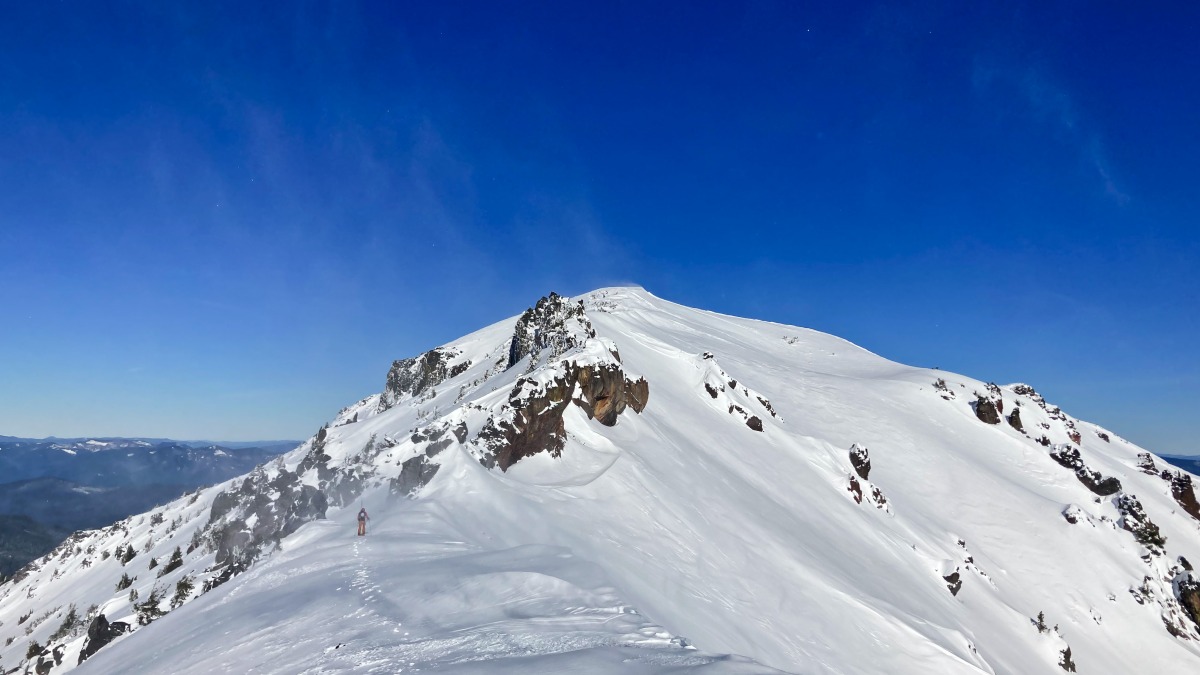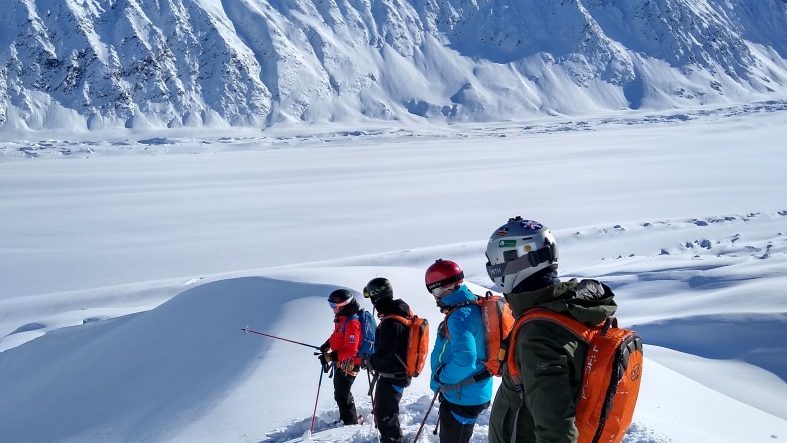
Learning in the field, a group discussing terrain features in Alaska’s Northern Chugach. Photo: Jordy Hendrikx
Tis’ the season. Leaves are turning. Already, in the West, snow dusts higher elevations. More accurately, it’s the tease season — when skiable snow is likely several months away. We lust anyhow. The season also teases since adventure film studios and brands release their latest trove of ski films. Which, I’m told, can infect people with an insatiable desire to ski.
Some call it powder fever.
What exactly are the symptoms of “powder fever”? Since we’re exploring the science literature, we’ll accept that “powder fever” is “a concept used by riders (skiers, snowmobilers, etc.) to describe the euphoric feeling and excitement, or anticipation that arises when they either ride or anticipate riding fresh snow or ‘powder.’”
Jordy Hendrikx, the Director of Montana State University’s Snow and Avalanche Lab, and a group of three co-authors, developed this working definition for their study Powder Fever and Its Impact on Decision-Making in Avalanche Terrain.
Over the past decade, avalanche education has morphed from an emphasis on digging pits and doing stability tests to include more on human factors we should consider when making sound decisions in relatively unpredictable environments. When I read the paper’s title, I assumed the worst – of course, the fever clouds judgment.
“What we found is that in that setting [our experimental design] a change in your emotional state didn’t necessarily change the risk assessment,” said Hendrikx when summarizing the study’s results.
The paper analyzed results from three experiments — two in a lab setting, the third in the field (during powder days). The two lab experiments involve videos designed to elicit either positive or negative emotions. One video features the usual ski film tropes: powder shots, helicopters, sun-kissed peaks, spine skiing, and a groove-tune. A roiling avalanche swallows a skier in the negative emotion video (killing no one).
The “powder fever” study is premised on a behavioral study looking at sexual arousal in young males and their propensity to engage in risky behavior.
Hendrikx summarized the findings of the sexual arousal study as follows: “These young men stated that they were far more willing to engage in risky behavior and do things that normally they probably wouldn’t think are very savory things to be doing. There’s a huge difference between their answers, while aroused, and a huge difference compared to when they’re non aroused, i.e. in the hot state versus what they call the cold state (non aroused).”
It’s easy to see where we are going here. Hypothetically, “powder fever” is the hot state.
“We tried to understand if the powder fever or some proxy of that could elicit responses that were maybe riskier or less desirable from an avalanche safety perspective,” said Hendrikx.
The researchers found that a skier’s emotional state is affected by watching a film or skiing powder. However, watching a video does not make one prone to take more risks, at least in a lab setting. The third study, administered in the field, found a negligible link between powder fever and risk-taking.
“And what we found is that in that setting, a change in your emotional state didn’t necessarily change the risk assessment,” remarked Hendrikx.
Hendrikx clarified the scientists did not measure real-world decision making. “What you choose to do in the mountains and your decisions after you’ve spent Friday night watching a bunch of ski movies, maybe it’s different, maybe there is an impact on some level (e.g. objective setting), but we couldn’t measure it in these particular studies,” he said.

A heavy wind working left to right helps keep the powder fever on Mt. Bailey at bay.
The paper concludes with a poignant statement. “These are reassuring findings, as it may indicate that backcountry experience and avalanche training are well entrenched in the populations tested in these studies.”
Stoke is a powerful emotion. But in this instance, not all consuming. Despite subjects showing a changed, more positive, emotional state, they were still not willing to increase their risk in a measurable way.
Hendrikx’s worldview and his life’s work mesh with that conclusion. When he speaks of decision making in hazardous terrain, he has a way of making you think he’s got your back. Identifying decision making pitfalls has been a cornerstone of his research for a decade.
“We are really trying to understand how we learn how to make good decisions and how that progression changes over time,” Hendrikx said. “I think it’s fascinating from a science perspective because the avalanche world and decision making in avalanche terrain don’t often give us a lot of feedback that we can learn from. It’s what we call this ‘wicked learning environment’ where we can make mistakes multiple times, and nothing happens. So then we don’t enact any corrective behavior to our mistakes; we just get lucky. And then, all of a sudden, we make the same mistake that we probably made 20 times before but never knew. We hit the sweet spot, we trigger the whole slope, and we may not survive that mistake.”
Avalanche mitigation goes back centuries in Europe. Policies were implemented more to keep people and their property out of harm’s way; the concept of recreation on speculative snow slopes had not yet taken hold. Once humans began questing in places like the Alps and the Canadian Rockies, and some individuals became avalanche statistics, avalanche mitigation became increasingly more professionalized.
Hendrikx explained learning from fatalities is grim but valuable work. But it has its limitations. The carrot in his quest is learning from avalanche survivors and “tracking their real-world decisions” and how their decision making evolves long term.
All this, Hendrikx explained, should be qualified. Understanding the pathways to sound or risky decisions is foundational. So too are a proper understanding of the snow and terrain and “applying sound decision making practices in the context of this information.”

Big terrain warrants keen decision making in the Northern Chugach. Photo: Jordy Hendrikx
For now, the various research groups Hendrikx collaborates with mix psychology, behavioral economics, and snow science to good effect. They are illuminating the meta of our decision making — causing us to tread with just a bit more trepidation, so we can know when we might not know.
Hendrikx had this advice if ever we find ourselves second-guessing. “Enforce a timeout, and do that in a really good way, before you make a critical decision.” This could be digging a pit, anything really, to get the group to slow down, and be present, “and get their factual data collection mindset on, and going, ‘alright, what are we looking for, what does the snowpack tell us that we may have missed, and are we all communicating, what have we missed?'”
In the meantime, if that off-shore buoy you’re fixated on predicts a dump in the hills a few days out, the data say it’s OK to watch that ski flick. The powder fever likely won’t cloud your judgment.
The film linked here, Powder Arousal, made by Emily Lea, is a resource exploring the link between risk perception, heightened emotions, and making decisions in the backcountry.
Jason Albert comes to WildSnow from Bend, Oregon. After growing up on the East Coast, he migrated from Montana to Colorado and settled in Oregon. Simple pleasures are quiet and long days touring. His gray hair might stem from his first Grand Traverse in 2000 when rented leather boots and 210cm skis were not the speed weapons he had hoped for. Jason survived the transition from free-heel kool-aid drinker to faster and lighter (think AT), and safer, are better.
